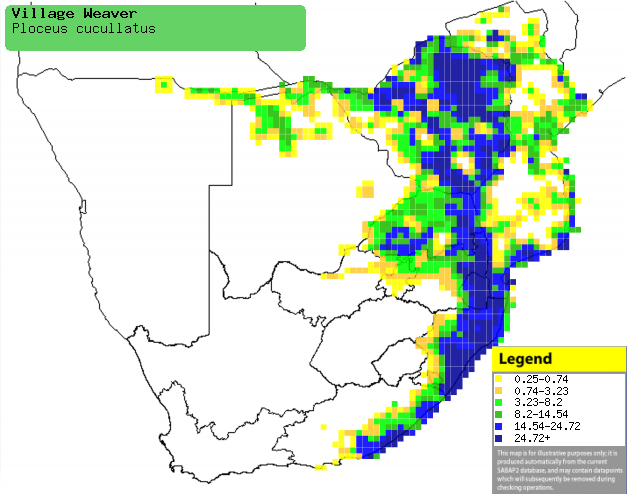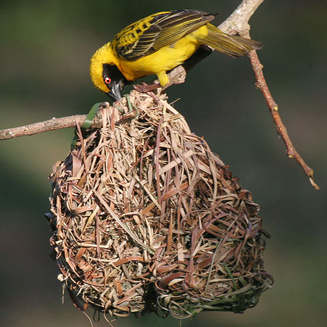|
Ploceus cucullatus (Village weaver , Spotted-backed weaver)
Bontrugwewer [Afrikaans]; Ihobo-hobo
(generic term for weaver) [Xhosa]; iHlokohloko (generic term for weaver)
[Zulu]; Letholopje (also applied to Cape weaver) [South Sotho]; Thaga
(also applied to Scaly-feathered finch) [North Sotho]; Jesa (generic name
for weaver) [Shona]; Lihlokohloko (generic for weavers) [Swazi]; Ndzheyana
(generic term for weaver or quelea) [Tsonga]; Thaga (generic term for
weaver) [Tswana]; Grote textorwever [Dutch]; Tisserin gendarme [French];
Textor, Dorfweber [German]; Tecel„o-malhado [Portuguese]
Life
> Eukaryotes >
Opisthokonta
> Metazoa (animals) >
Bilateria >
Deuterostomia > Chordata >
Craniata > Vertebrata (vertebrates) > Gnathostomata (jawed
vertebrates) > Teleostomi (teleost fish) > Osteichthyes (bony fish) > Class:
Sarcopterygii (lobe-finned
fish) > Stegocephalia (terrestrial
vertebrates) > Tetrapoda
(four-legged vertebrates) > Reptiliomorpha > Amniota >
Reptilia (reptiles) >
Romeriida > Diapsida > Archosauromorpha > Archosauria >
Dinosauria
(dinosaurs) > Saurischia > Theropoda (bipedal predatory dinosaurs) >
Coelurosauria > Maniraptora > Aves
(birds) > Order: Passeriformes
> Family: Ploceidae > Genus: Ploceus
Distribution and habitat
Occurs across much of sub-Saharan Africa, from Mauritania
to Ethiopia south to southern Africa, where it is common from Zimbabwe and
Mozambique to the eastern half of South Africa, with localised populations in
northern Botswana and north-eastern Namibia. It generally prefers woodland or
forest along rivers, thornveld and parks and gardens, especially near water.
|
 |
|
Distribution of Village weaver in southern Africa,
based on statistical smoothing of the records from first SA Bird Atlas
Project (©
Animal Demography unit, University of
Cape Town; smoothing by Birgit Erni and Francesca Little). Colours range
from dark blue (most common) through to yellow (least common).
See here for the latest distribution
from the SABAP2. |
Predators and parasites
It (at different stages of development) has been recorded
as prey of the following animals:
Brood parasites
It has been recorded as host of the
Diderick
cuckoo.
Food
It mainly eats insects, seeds and nectar, gleaning food
from the ground and foliage and hawking termite alates aerially. The following food items have been recorded
in its diet:
- Insects
- Plants
- nectar
- Aloe barberae (Eastern tree aloe)
- Aloe ferox (Bitter aloe)
- Erythrina caffra (Coast coral-tree)
- Erythrina latissima (Broad-leaved coral-tree)
- Schotia (boer-beans)
- seeds
- ovaries and stamens of flowers
- Human food, such as picnic table scraps.
Breeding
- Polygynous, territorial colonial nester, with colonies of about 10-300
breeding males, each mating with about 0-5, usually 2 females per breeding
season. Each male defends a small territory around his nests, displaying and
advertising themselves by erecting their mantle feathers and chasing the
female, in a bid for her to inspect the nest. If she accepts that the nest's
structure is secure they mate and use it to rear their brood.
- Each male builds 3-5 nests, each taking about 9-15 hours to complete,
consisting of a kidney shaped structure with a large entrance in the
underside. It is usually woven from green strips of reeds, grass leaves or
palm blades; if accepted by the female he adds a short entrance tunnel,
while the female lines the interior with soft grass heads and feathers. It
is typically attached to the thin branch of a tall, free-standing tree, and
is never used more than once.
 |
|
|
Village weaver male on nest, South Africa. [photo
Jim Scarff
©] |
|
- Egg-laying season is from August-April, peaking twice from
September-October and from January-February.
- It lays 2-5 eggs, which are incubated solely by the female for about 12
days.
- The chicks are brooded by the female only but fed by both parents on a
diet of mainly insects, leaving the nest after about 17-21 days.
Threats
Not threatened.
References
-
Hockey PAR, Dean WRJ and Ryan PG 2005. Roberts
- Birds of southern Africa, VIIth ed. The Trustees of the John Voelcker
Bird Book Fund, Cape Town.
|
